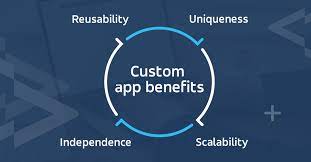The Power of Custom Web Applications
In today’s digital age, businesses are constantly seeking ways to enhance their online presence and streamline their operations. Custom web applications have emerged as a powerful solution to meet these demands, offering tailored functionalities that off-the-shelf solutions simply cannot provide.
What are Custom Web Applications?
Custom web applications are bespoke software solutions designed to address specific business needs. Unlike off-the-shelf software, custom web applications are built from the ground up to align with the unique requirements of a particular business or industry.
The Benefits of Custom Web Applications
Tailored Functionality: Custom web applications are built to cater to the exact needs of a business, ensuring that every feature serves a specific purpose and contributes to operational efficiency.
Scalability: As businesses grow and evolve, custom web applications can easily scale to accommodate increased data volumes, user traffic, and additional features without compromising performance.
Enhanced Security: With custom web applications, businesses have greater control over their security measures, allowing them to implement robust protocols tailored to their specific requirements and compliance standards.
Improved User Experience: By focusing on user-centric design and functionality, custom web applications offer a seamless and intuitive experience for both internal users and customers interacting with the platform.
Examples of Custom Web Applications
– Customer Relationship Management (CRM) systems tailored to unique sales processes
– Inventory management systems designed for specific industry requirements
– Project management tools customised for team collaboration and task tracking
– E-commerce platforms with personalised shopping experiences
– Data analytics dashboards for in-depth insights into business performance
Conclusion
Custom web applications empower businesses to innovate, adapt, and thrive in an increasingly competitive digital landscape. By investing in bespoke software solutions that align with their goals and processes, organisations can unlock new opportunities for growth, efficiency, and success.
Five Essential Tips for Developing Custom Web Applications: From Conceptualisation to Security
- Clearly define the requirements and objectives of the custom web application before starting development.
- Consider scalability and future expansion when designing the architecture of the web application.
- Prioritize user experience (UX) design to ensure that the application is intuitive and easy to use.
- Regularly test and debug the custom web application to maintain its functionality and performance.
- Implement robust security measures to protect sensitive data and prevent cyber threats.
Clearly define the requirements and objectives of the custom web application before starting development.
It is crucial to clearly define the requirements and objectives of a custom web application before embarking on the development process. By establishing a solid foundation of what the application needs to achieve and how it should function, businesses can ensure that the final product meets their specific needs and aligns with their goals. This upfront clarity not only guides developers in creating a tailored solution but also helps stakeholders stay focused on delivering a successful custom web application that addresses key business challenges effectively.
Consider scalability and future expansion when designing the architecture of the web application.
When developing custom web applications, it is crucial to consider scalability and future expansion in the architecture design. By anticipating potential growth and changes in user volume or functionality requirements, businesses can ensure that their web application remains robust and adaptable over time. Building a scalable architecture from the outset allows for seamless integration of new features, increased data storage capacity, and enhanced performance as the application evolves to meet the changing needs of the business and its users.
Prioritize user experience (UX) design to ensure that the application is intuitive and easy to use.
When developing custom web applications, it is crucial to prioritise user experience (UX) design to guarantee that the application is intuitive and user-friendly. By focusing on creating a seamless and engaging interface, businesses can ensure that users can navigate the application effortlessly and accomplish their tasks efficiently. A well-designed UX not only enhances user satisfaction but also contributes to increased adoption rates and overall success of the custom web application.
Regularly test and debug the custom web application to maintain its functionality and performance.
Regularly testing and debugging a custom web application is crucial to ensuring its continued functionality and performance. By conducting routine tests and addressing any issues promptly, businesses can identify and resolve potential bugs or glitches that may impact user experience or system efficiency. This proactive approach not only helps maintain the application’s reliability but also enhances its overall performance, providing users with a seamless and error-free experience. Prioritising regular testing and debugging is key to maximising the long-term effectiveness of a custom web application.
Implement robust security measures to protect sensitive data and prevent cyber threats.
It is crucial for businesses investing in custom web applications to implement robust security measures to safeguard sensitive data and mitigate the risk of cyber threats. By prioritising security, organisations can establish a secure digital environment that protects confidential information, maintains customer trust, and minimises the potential impact of cyber attacks. Implementing encryption protocols, access controls, regular security audits, and staying informed about emerging threats are essential steps in fortifying the resilience of custom web applications against malicious activities.

